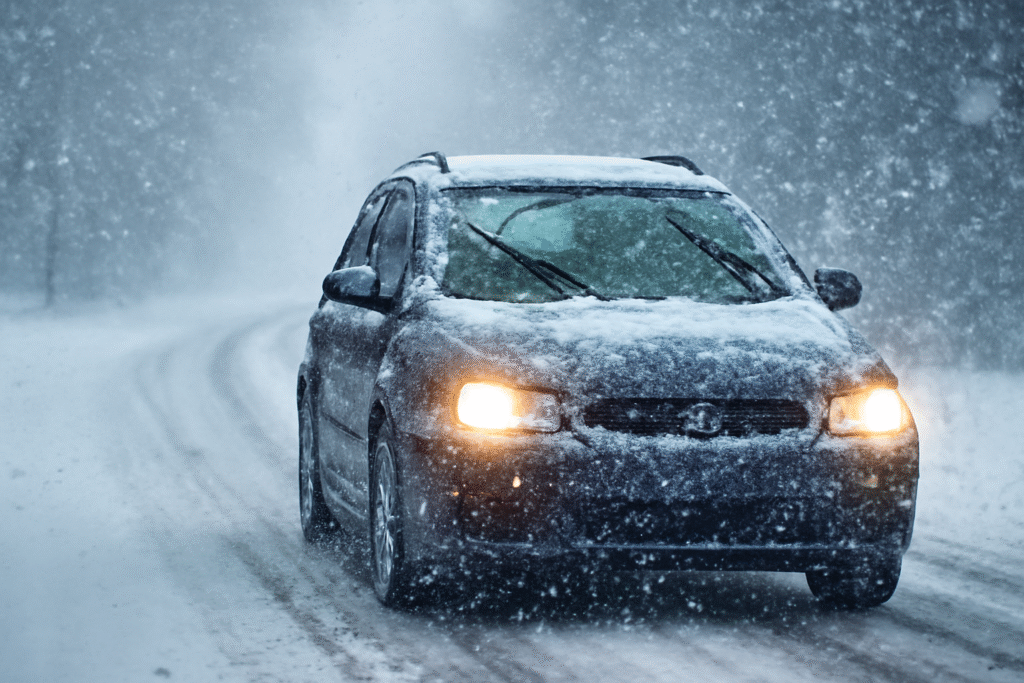
10 Essential Tips for Winterizing Your Car and Preventing Cold Weather Breakdowns
Winter can be tough on your car, with freezing temperatures, snow, and ice putting extra strain on your vehicle. 
In this guide, we’ll walk you through 10 essential steps that will not only help you avoid common cold-weather car issues but also give you peace of mind on the road. From checking your battery to making sure your tires are winter-ready, these tips are simple yet powerful ways to prepare your vehicle for the harsh winter months ahead.
So, whether you’re a first-time winter driver or a seasoned pro, keep reading to discover how to keep your car running smoothly and stay safe throughout the season. Let’s dive into these practical, easy-to-follow tips for winterizing your car!
Table of Contents
ToggleCheck Your Battery Health
Your car’s battery is essential for starting your vehicle, especially in cold weather. Cold temperatures can cause your battery to lose power more quickly, making it harder to start your car on chilly mornings. 
Why Battery Health Matters in Winter 
As temperatures drop, the chemical reactions inside your battery slow down, reducing its ability to hold a charge. This is why many car owners experience starting issues during winter. Checking your battery’s health before the cold sets in can save you from unpleasant surprises.
How to Check Your Battery Health 
- Inspect for Corrosion: Look for any corrosion around the battery terminals (the metal connections where cables attach). Corrosion can prevent your car from starting and may even damage your electrical system.
- Tip: Clean any corrosion with a mixture of baking soda and water.
- Test Battery Voltage: Use a multimeter to check your battery’s voltage. A healthy battery should read between 12.6 to 12.8 volts when the engine is off. If the reading is below 12.4 volts, your battery might be weak and could need replacing soon.
- Consider Battery Age: Car batteries typically last around 3-5 years. If yours is older than that, it’s a good idea to replace it before winter to avoid any risk of failure.
- Pro Tip: If your battery is nearing its expiration date, consider getting it tested at an auto shop for further assurance.
What to Do if Your Battery Is Weak 
If your battery isn’t in top shape, replace it before the first frost. A new, fully charged battery will ensure you don’t face the hassle of a dead car in freezing temperatures.

Inspect and Replace the Engine Coolant
Engine coolant, also known as antifreeze, is crucial for keeping your car’s engine at the right temperature. During winter, it helps prevent the engine from freezing and ensures it doesn’t overheat when driving in extreme cold. 
Why Engine Coolant Matters in Winter 
When temperatures drop, your engine coolant prevents the coolant in the radiator from freezing, which could lead to engine damage. It also helps in regulating the engine’s temperature by dispersing heat, keeping it from overheating even in colder months. Without proper coolant, your engine could seize, causing costly repairs.
How to Inspect and Maintain Your Engine Coolant 
- Check the Coolant Level: Start by checking the coolant level in the radiator reservoir. It should be between the “MIN” and “MAX” lines on the tank.
- Pro Tip: If the coolant is low, top it up with the correct antifreeze (refer to your car’s manual for the recommended type).
- Inspect the Color of the Coolant: Healthy coolant is usually bright green, orange, or pink. If it looks rusty or brown, it’s time for a replacement. Dark, contaminated coolant means it has lost its effectiveness and may cause engine issues.
- Test the Coolant Mixture: The ideal coolant mixture is 50% antifreeze and 50% water. If the mixture is off, it can affect the freezing and boiling points, leading to potential engine problems.
- Tip: You can buy a coolant tester at an auto parts store to easily check the mixture.
How to Replace Your Engine Coolant 
- Flush the System: If your coolant is old or contaminated, consider flushing the entire cooling system. This will remove any buildup and ensure fresh coolant is circulating properly.
- Pro Tip: Some vehicles require a special coolant flush procedure. If you’re unsure, ask a professional mechanic.
- Refill with Fresh Coolant: After flushing, refill the system with fresh coolant. Make sure it’s the correct type for your vehicle to avoid any damage to the cooling system.
Benefits of Regular Coolant Maintenance 
Maintaining proper coolant levels and quality will help your car run smoothly and avoid freezing, overheating, or expensive engine repairs. It’s a small step that goes a long way in winterizing your car.

Change Your Oil and Use the Right Grade
Changing your car’s oil is one of the most important maintenance tasks to keep your engine running smoothly, especially during the winter months. Cold temperatures can make oil thicken, causing the engine to work harder and increasing the risk of wear and tear.
Why Oil Matters in Winter 
During winter, your engine oil needs to flow smoothly even in freezing temperatures. If the oil is too thick, it won’t lubricate the engine properly, which can lead to poor performance and even damage over time. Using the right oil grade ensures your engine starts up easily and runs efficiently.
How to Choose the Right Oil for Winter 
- Pick the Right Oil Grade: The viscosity of the oil (how thick or thin it is) is critical in cold weather. For winter, it’s recommended to use a thinner oil such as 5W-30 or 0W-20. The “W” stands for winter, and the lower the number, the thinner the oil will be at low temperatures.
- Pro Tip: Always check your car’s manual for the recommended oil grade for winter.
- Synthetic Oil Is a Great Choice: Synthetic oils are better suited for extreme temperatures because they flow better in the cold. They also tend to last longer, which means you won’t have to change your oil as frequently.
When and How to Change Your Oil 
- Check the Oil Level: Before winter arrives, check your oil level using the dipstick. If it’s low, top it up with the correct oil. If the oil looks dirty or dark, it’s time for a change.
- Pro Tip: If you’re unsure whether your oil needs changing, it’s safer to change it before the cold weather hits.
- Regular Oil Changes: Generally, you should change your oil every 3,000 to 5,000 miles, depending on your car’s model and driving conditions. Be sure to replace both the oil and the filter for the best performance.
Benefits of Changing Your Oil 
Changing your oil before the cold weather sets in ensures your engine is properly lubricated and ready to perform in freezing temperatures. Using the correct oil grade also helps prevent damage, increases fuel efficiency, and prolongs the life of your engine.

Examine Your Tires and Check Tread Depth
Your tires are your car’s only point of contact with the road, so ensuring they are in good condition is essential—especially when dealing with cold, icy, or snowy weather. Poor tire maintenance can lead to dangerous driving conditions, including losing traction on slick surfaces.
Why Tire Health Is Crucial in Winter 
Cold weather can cause tire pressure to drop, and icy roads can make it harder for your tires to grip the road. To stay safe, it’s important to ensure your tires are ready for the challenges that winter brings. This includes checking their tread depth and ensuring they are properly inflated.
How to Examine Your Tires 
- Check Tire Pressure: Cold temperatures can cause tire pressure to drop by about 1-2 psi for every 10°F drop in temperature. Under-inflated tires reduce fuel efficiency and can cause your car to handle poorly in winter conditions.
- Pro Tip: Check your tire pressure once a month using a tire gauge and top it up if necessary. Refer to your car’s manual for the recommended tire pressure.
- Inspect for Visible Damage: Look for cracks, bulges, or punctures in the sidewalls of your tires. Any visible damage should be addressed immediately, as it can lead to tire failure.
Check Tire Tread Depth 
Tire tread depth is one of the most important factors in winter driving. The deeper the tread, the better your tires can grip the road, especially in snow or rain.
- How to Check Tread Depth:
- Use the “penny test” to check tread depth. Place a penny in the tire’s tread groove with Lincoln’s head facing down. If you can see the top of his head, your tread is too low, and it’s time to replace the tire.
- Tip: Tires should have a minimum of 4/32” of tread depth for winter driving. If it’s any lower, replace the tires to ensure maximum traction.
- Consider Winter Tires: If you live in an area with heavy snow or ice, consider switching to winter tires. These tires are designed with deeper, more aggressive treads that provide better traction in slippery conditions.
- Pro Tip: Winter tires have a higher rubber content that stays more flexible in colder temperatures, providing superior grip.
Benefits of Proper Tire Maintenance 
Maintaining proper tire pressure and ensuring the tread depth is sufficient can dramatically improve your car’s performance and safety on winter roads. Well-maintained tires help prevent accidents, increase fuel efficiency, and make your driving experience smoother during harsh weather conditions.

Inspect and Replace Wiper Blades
Clear visibility is crucial when driving in winter, especially with snow, ice, and rain that can quickly obscure your windshield. Wiper blades play a vital role in ensuring you can see clearly, but they can wear down over time.
Why Wiper Blades Matter in Winter 
In cold weather, worn-out wiper blades can leave streaks or fail to clear snow and ice, reducing visibility and making driving dangerous. Winter conditions can also cause wiper blades to freeze, and if they are in poor condition, they may break or stop working altogether.
How to Inspect and Maintain Wiper Blades 
- Check for Wear and Tear: Inspect your wiper blades for any cracks, tears, or signs of hardening. If they leave streaks or fail to wipe your windshield clean, it’s time to replace them.
- Pro Tip: If you notice any damage to the rubber or that the wiper blades don’t make full contact with the glass, replace them.
- Inspect for Frozen Wipers: During snowstorms or extreme cold, wiper blades can freeze to the windshield. Make sure to remove any ice build-up before turning on the wipers to avoid damaging them.
How to Replace Wiper Blades 
- Choosing the Right Wiper Blades: In winter, choose wiper blades designed specifically for cold weather. Winter wiper blades are built with stronger frames and rubber that resist freezing and are more efficient in harsh weather conditions.
- Pro Tip: Winter wiper blades are usually labeled “winter” or “heavy-duty” and have a protective cover to prevent ice build-up.
- How to Replace Them:
- Lift the wiper arm away from the windshield.
- Locate the small tab on the wiper blade and press it to release the blade from the arm.
- Slide the new wiper blade onto the arm and secure it in place.
- Tip: Always replace both wiper blades at the same time for uniform performance.
Benefits of Proper Wiper Blade Maintenance 
Maintaining good wiper blades ensures clear visibility in any weather, making your winter driving safer. By replacing old or damaged wiper blades and switching to winter-specific ones, you’ll be better prepared for the icy conditions that often occur during the colder months.

Check Your Heater and Defroster
During winter, your heater and defroster aren’t just for comfort—they are essential for visibility and safety. Without a properly working heater and defroster, you risk fogged-up windows, discomfort, and even dangerous driving conditions.
Why Heater and Defroster Maintenance Is Essential 
Your car’s heater helps keep you warm, but it also plays a critical role in preventing your windshield from fogging up. The defroster uses warm air to clear frost or condensation from the glass, ensuring you have a clear line of sight in winter weather. Without these systems working efficiently, you may find yourself driving blind through snow or rain.
How to Inspect Your Heater and Defroster 
- Test the Heater: Before winter sets in, turn on your heater and check if it blows warm air. If the air is lukewarm or not heating up properly, there may be an issue with the heater core, thermostat, or coolant level.
- Pro Tip: Make sure the air is blowing from all vents, not just a few, to ensure even heat distribution throughout the cabin.
- Check the Defroster: Turn on the defroster and observe if the windshield clears up quickly. If the defroster isn’t working or takes too long to defrost, the system may need maintenance.
Common Problems with Heaters and Defrosters 
- Coolant Issues: If the coolant is low or the heater core is clogged, it can prevent the heater from working properly. Always check the coolant level and top it up if needed (refer to Tip #2 for more on coolant).
- Clogged Vents: Sometimes, leaves or debris can block the airflow to the heater and defroster. Make sure the air intake vents are clear of any obstructions.
- Pro Tip: Regularly clean the air vents to prevent any debris from affecting the system.
- Weak Airflow: If the air is warm but not blowing with enough force, the blower motor could be faulty. A professional mechanic can help fix this issue.
What to Do If There’s a Problem 
If your heater or defroster isn’t working properly, it’s essential to get it fixed before the winter months. A malfunctioning heater or defroster can lead to fogged-up windows or a cold, uncomfortable drive. For most issues, it’s best to consult a mechanic to ensure a proper repair.
Benefits of a Well-Functioning Heater and Defroster 
Having a working heater and defroster not only keeps you comfortable, but it also ensures that your visibility is clear, reducing the risk of accidents during winter weather. Regularly checking and maintaining these systems helps keep you safe and warm throughout the colder months.
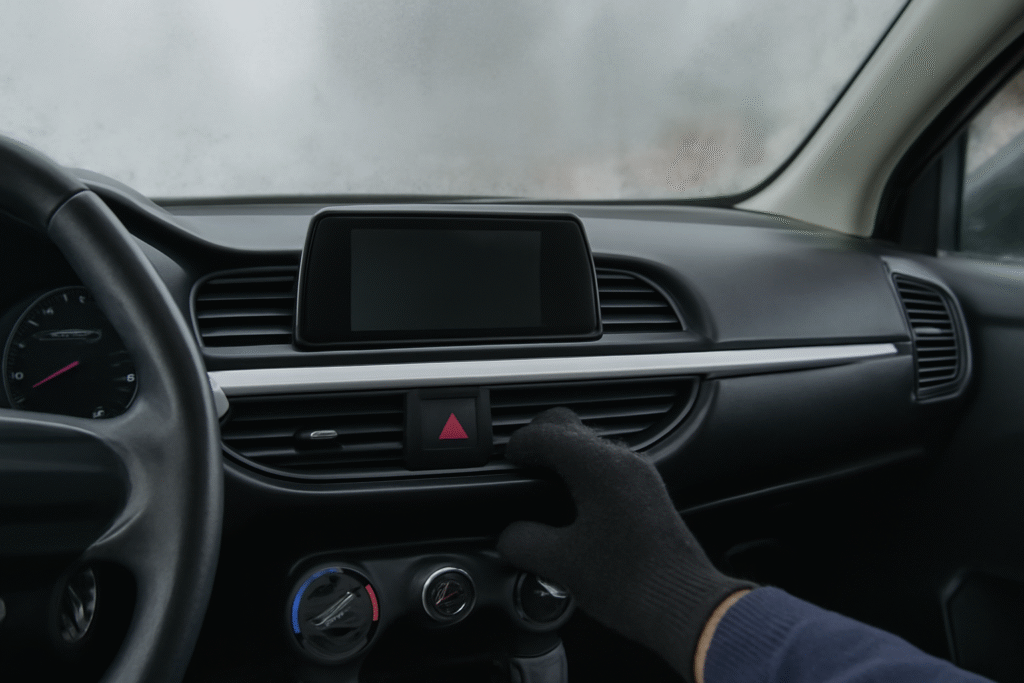
Lubricate Door Seals and Locks
As temperatures drop, the rubber seals around your car doors and locks can become stiff, brittle, or even freeze completely. This can lead to difficulty opening doors, water leaks, and added wear on the seals. Lubricating these components is a simple, effective way to prevent issues and keep your car in top shape during winter.
Why Lubricating Door Seals and Locks Is Important 
In cold weather, door seals and locks are especially vulnerable to freezing. If moisture builds up in the seals or locks, it can cause them to freeze shut, making it impossible to get in or out of your car. Lubricating these parts keeps them flexible, prevents ice buildup, and ensures that your doors open and close easily, even in the harshest conditions.
How to Lubricate Door Seals 
- Clean the Seals: Start by cleaning the rubber seals around your doors with a soft cloth to remove any dirt or debris. This helps the lubricant work more effectively.
- Apply Silicone Spray: Use a silicone-based spray lubricant specifically designed for rubber seals. Avoid using petroleum-based products, as these can cause the rubber to crack over time.
- Pro Tip: Spray the silicone lubricant directly on the seals, then wipe off any excess to avoid a mess.
- Rubber Conditioner: For extra protection, consider using a rubber conditioner on the seals. This will help keep them soft and prevent cracking from the cold.
- Tip: Don’t forget to lubricate the seals around your trunk and any other doors that may be exposed to the elements.
How to Lubricate Locks 
- Use Graphite Powder: For door locks, use graphite powder or a lock-specific lubricant. Avoid using oil-based products, as they can attract dirt and grime, which could cause the lock to malfunction.
- Spray Inside the Lock: Apply a small amount of graphite powder or lubricant inside the keyhole, then insert the key and turn it several times to distribute the lubricant evenly.
- Pro Tip: For locks that freeze easily, keep a de-icer handy to prevent them from freezing shut in extreme cold.
Benefits of Lubricating Your Door Seals and Locks 
Regular lubrication not only prevents freezing and cracking but also extends the life of your door seals and locks. It ensures that you can open and close your car easily, keeps moisture out of your vehicle, and prevents the frustration of frozen doors in the middle of winter.
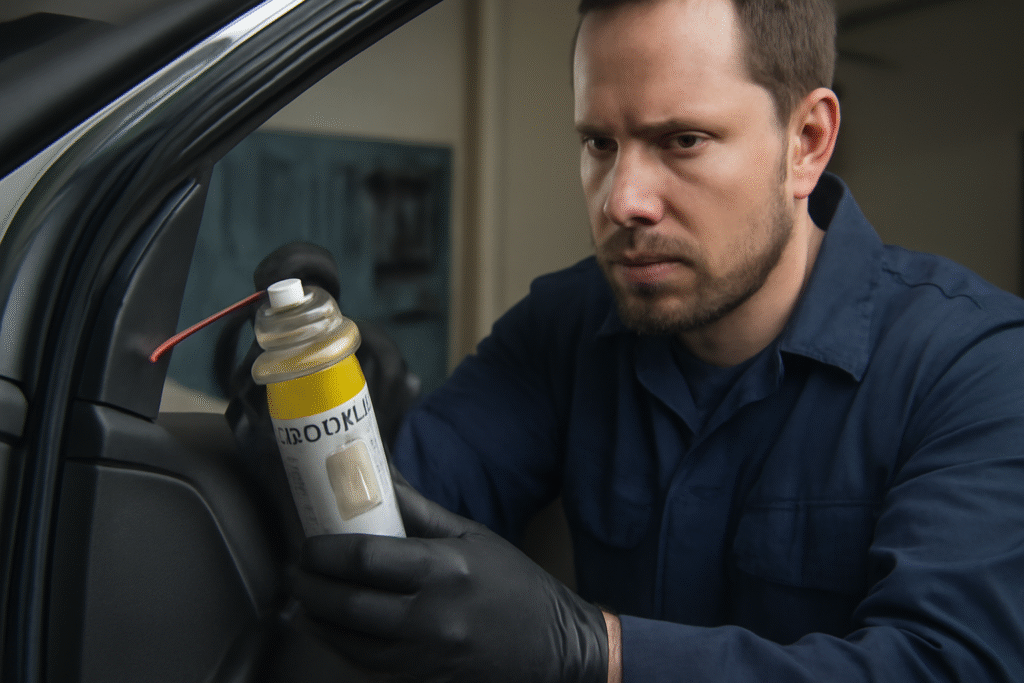
Check the Exhaust System
Your car’s exhaust system plays a vital role in reducing harmful emissions and ensuring your engine runs efficiently. In winter, however, the exhaust system can be vulnerable to damage from road salt, ice buildup, and temperature fluctuations. Regularly checking the system can prevent costly repairs and keep your vehicle running smoothly.
Why Exhaust System Maintenance Is Crucial in Winter 
The exhaust system helps remove gases from your engine, but in cold weather, snow, ice, and road salt can cause rust and corrosion. A damaged exhaust system can lead to loud noises, poor fuel efficiency, and even carbon monoxide leaks, which can be dangerous. Ensuring your exhaust system is in good condition is an essential step in winterizing your car.
How to Inspect the Exhaust System 
- Look for Visible Damage: Examine the exhaust pipes, muffler, and connectors for rust, holes, or cracks. Pay special attention to the areas near the undercarriage, as these parts are most exposed to road salt and debris.
- Listen for Unusual Noises: Start your engine and listen for any loud noises like rumbling or hissing coming from the exhaust. These sounds often indicate that there’s a hole or crack in the exhaust system.
- Check for Strong Exhaust Fumes: If you notice an increase in exhaust fumes or a strange smell, it could indicate a blockage or damage to the exhaust system, which should be addressed immediately.
What to Do if You Find Issues 
- Repair or Replace: If you notice visible damage or hear strange noises, have your exhaust system inspected and repaired by a professional mechanic. The repair could be as simple as patching a hole or as extensive as replacing a damaged muffler or catalytic converter.
- Get a Professional Inspection: If you’re unsure about the condition of your exhaust system, it’s a good idea to have a professional mechanic perform a thorough inspection. They’ll check for leaks, corrosion, and ensure that all components are functioning properly.
Benefits of a Well-Maintained Exhaust System 
A well-maintained exhaust system ensures that your car runs quietly, efficiently, and safely. It also reduces harmful emissions, improving the environmental performance of your vehicle. Regular checks and repairs prevent bigger, more costly issues down the road.
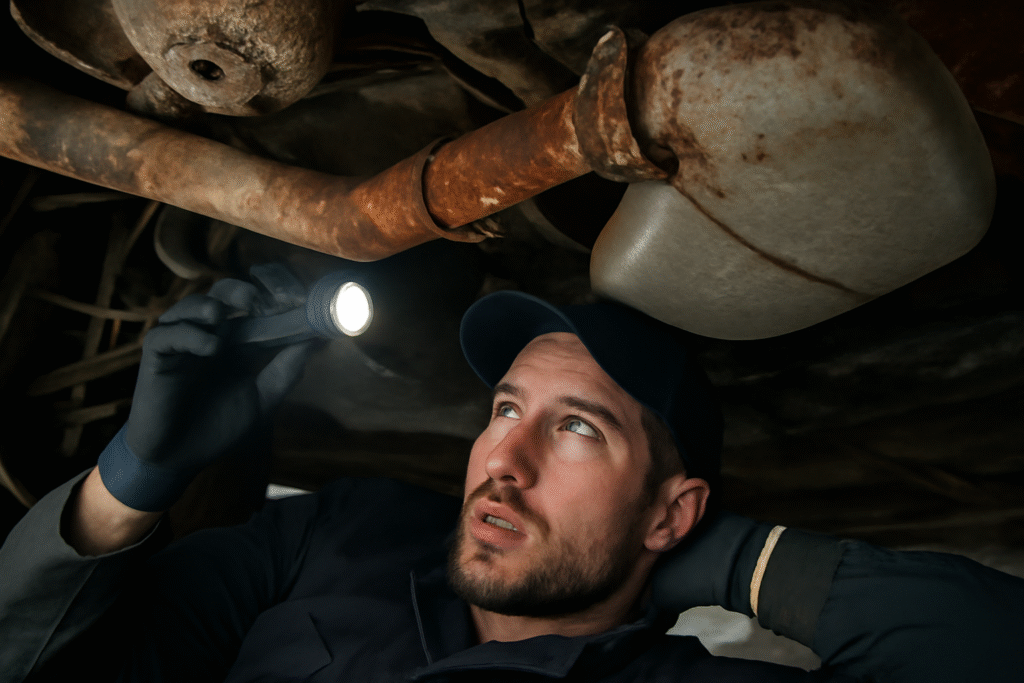
Prepare an Emergency Kit
Winter weather can be unpredictable, and even with the best preparation, car breakdowns or accidents can happen. Having a well-stocked emergency kit in your car can make all the difference if you’re stuck in the cold.
Why an Emergency Kit Is Essential 
In extreme weather, you may find yourself stranded or facing unexpected delays. An emergency kit ensures that you’re prepared for any situation, whether it’s a flat tire, a breakdown, or getting stuck in the snow. It’s better to be over-prepared than to be caught off guard without the essentials.
Must-Have Items for Your Emergency Kit 
- Jumper Cables: A dead battery is one of the most common winter issues. Jumper cables can help you get back on the road quickly, especially if you’re in a remote area and don’t have access to help.
- Flashlight and Extra Batteries: In case you’re stranded in the dark, a flashlight is essential. Make sure to pack extra batteries to keep it working when needed.
- Pro Tip: Consider a headlamp, which frees up your hands for other tasks.
- First-Aid Kit: Always be ready for minor injuries. A basic first-aid kit with bandages, antiseptic wipes, and pain relievers can come in handy during an emergency.
- Blanket, Warm Clothing, and Gloves: If you’re stuck in your car for an extended period, you’ll want to stay warm. A blanket, along with extra clothing such as hats, gloves, and scarves, will help you maintain body heat.
- Tip: Opt for thermal blankets that retain heat.
- Food and Water: Pack non-perishable snacks like granola bars, nuts, or trail mix. These can provide you with energy if you’re waiting for help. Don’t forget to include a bottle of water to stay hydrated.
- Ice Scraper and Snow Brush: These are essential for clearing your windshield and windows of snow and ice. Make sure the scraper is sturdy enough to handle thick ice buildup.
- Sand or Cat Litter: If you get stuck in the snow, sand or cat litter can provide traction to help you get moving again. Spread it around your tires and under your car to improve grip on slippery surfaces.
- Tow Rope or Chain: A tow rope or chain can help you or someone else get out of a tough situation if you’re stuck in deep snow or mud.
- Phone Charger: Make sure to have a car charger with a USB cable, so your phone is always charged and ready to call for help if necessary.
How to Store Your Emergency Kit 
- Use a Storage Bag: Store all the emergency items in a compact, easy-to-carry bag or box. Make sure it’s large enough to hold everything but small enough to fit in your car’s trunk or backseat.
- Keep It Accessible: Make sure your emergency kit is easy to reach in case you need it quickly. Don’t bury it under heavy items in the trunk.
Benefits of an Emergency Kit 
Having a fully stocked emergency kit gives you peace of mind knowing that you’re prepared for any situation. It reduces stress in an emergency and could even save your life if you’re stranded in severe conditions. It’s a small investment that can make a big difference in winter safety.
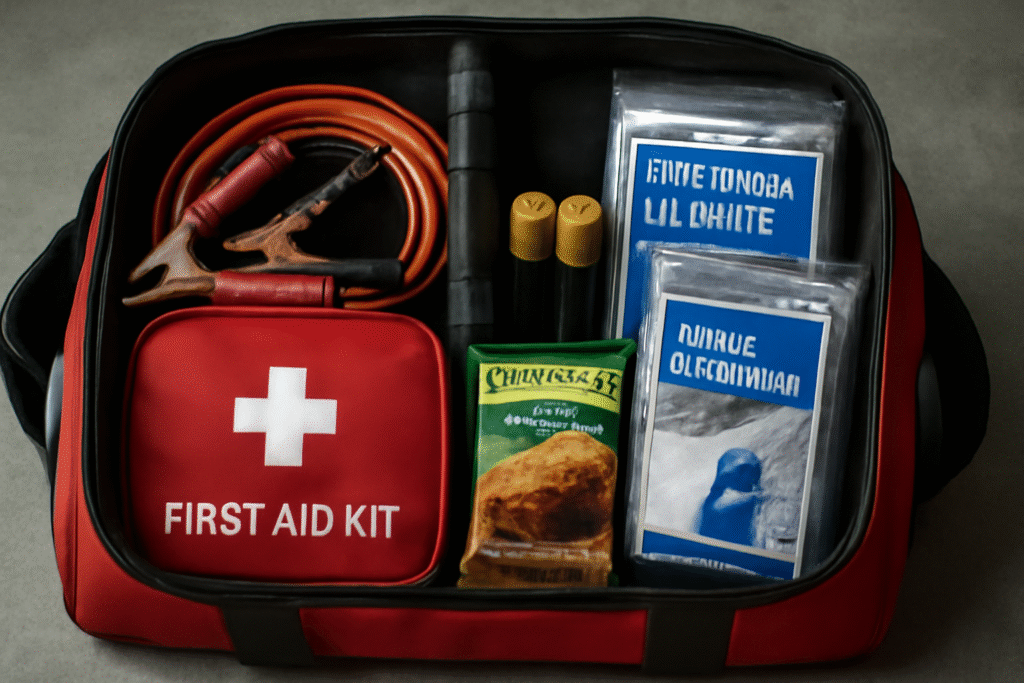
Keep Gas Tank Half-Full
In winter, it’s especially important to keep your gas tank at least half-full. While this may seem like a small detail, it can make a big difference when dealing with cold weather.
Why a Full Gas Tank Is Important in Winter 
Cold temperatures can cause moisture in your gas tank to freeze, which may block the fuel lines and cause your engine to stall. Keeping your gas tank at least half-full helps prevent this from happening. A fuller tank also ensures you have enough fuel if you get stuck or need to drive longer distances in bad weather.
The Benefits of Keeping Your Tank Half-Full 
- Prevents Frozen Fuel Lines: A full tank of gas reduces the chances of condensation forming inside the tank, which can freeze and block fuel lines. This is especially crucial in freezing temperatures when moisture is more likely to accumulate.
- Provides Emergency Backup: If you get stuck in traffic or are forced to detour due to bad weather, having enough fuel in your tank means you won’t run out of gas. This is particularly important during snowstorms or when driving in remote areas.
- Improves Fuel Efficiency: Running your car on a half-full tank can also improve fuel efficiency. A fuller tank gives your car a more stable fuel supply, especially in cold weather when fuel lines can be more sensitive.
When to Refuel 
- Don’t Wait Until You’re Almost Empty: It’s easy to forget about refueling when you’re busy, but it’s a good habit to fill up when your tank is about halfway. This will keep you safe and ready for any emergencies.
- Top Up Regularly: If you know a winter storm is coming or you’re planning a long drive, fill up your tank even earlier. It’s always better to have more fuel than less when conditions are unpredictable.
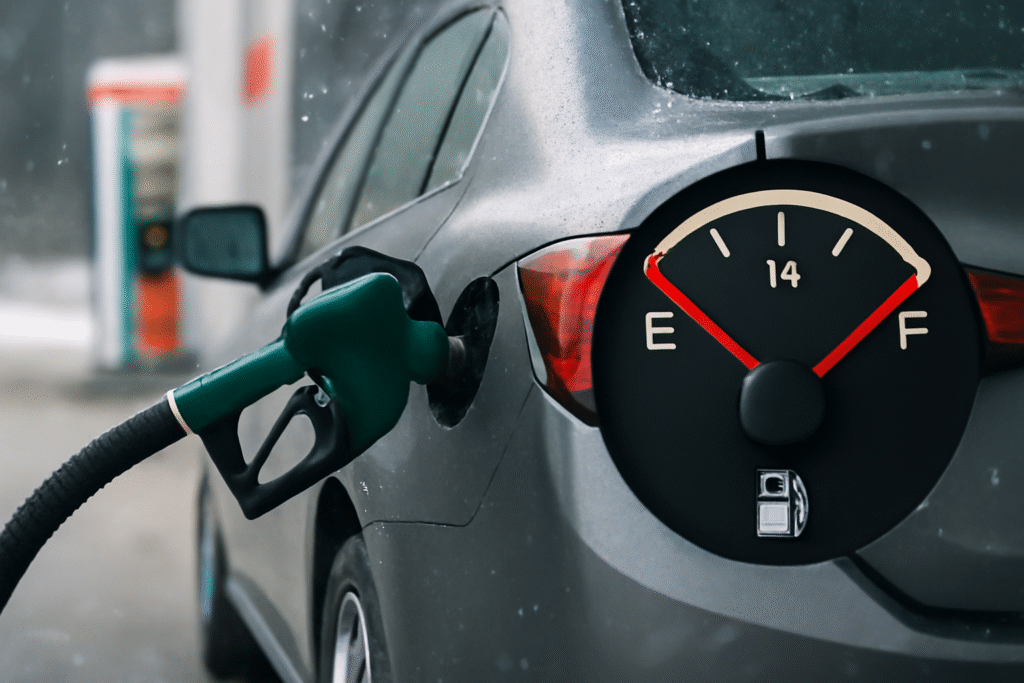
Winterizing your car is essential to ensure it runs smoothly and safely through the cold months. By following these 10 essential tips for winterizing your car, you’ll be well-prepared for whatever the season throws your way. From checking your battery health to keeping your gas tank half-full, these small but impactful actions will help prevent breakdowns and keep you on the road without worry.
Remember, regular maintenance and preparation go a long way in avoiding costly repairs and ensuring your vehicle remains reliable, even in the harshest winter conditions. Whether you’re driving through snow, ice, or freezing temperatures, these simple steps can make a big difference in your safety and comfort.
Take the time to winterize your car now, and you’ll have peace of mind all season long. Stay safe, warm, and confident behind the wheel!

Frequently Asked Questions (FAQs)
1. Why is it important to winterize my car?
Winterizing your car is essential to ensure it runs smoothly and safely during cold weather. Cold temperatures can cause issues like frozen fuel lines, weak batteries, and poor visibility, making it harder to drive safely. Winterizing helps prevent breakdowns and reduces the risk of costly repairs.
2. How do I know if my car's battery is ready for winter?
Check your battery’s voltage with a multimeter—anything below 12.4 volts means it may need replacing. Also, look for signs of corrosion around the battery terminals. If your battery is over 3-5 years old, consider replacing it before winter hits to avoid unexpected issues.
3. How often should I change my oil in winter?
Change your oil every 3,000 to 5,000 miles, depending on your car’s model and driving conditions. In winter, it’s especially important to use the correct oil grade, such as 5W-30, to ensure smooth engine performance in cold temperatures.
4. How do I prevent my car doors from freezing?
Lubricate the rubber seals around your car doors with silicone spray to prevent them from freezing. Also, keep your locks and seals clean, and consider lifting the wiper blades off the windshield to prevent ice build-up.
5. How can I tell if my tires are ready for winter?
Check the tread depth by using the “penny test.” Insert a penny into the tread, and if you can see the top of Lincoln’s head, it’s time to replace the tires. Also, make sure your tire pressure is correct, as cold weather can cause it to drop.
6. What should I include in my car's emergency kit for winter?
Your emergency kit should include jumper cables, a flashlight, a first-aid kit, blankets, non-perishable food and water, an ice scraper, sand or cat litter for traction, and a phone charger. These items will help you stay safe and comfortable in case of an emergency.
7. Why is it important to keep my gas tank half-full in winter?
Keeping your gas tank at least half-full prevents moisture from forming inside the tank, which can freeze and block the fuel lines. A fuller tank also ensures you have enough fuel in case of unexpected delays or emergencies.
8. How do I check and replace my car’s coolant for winter?
Check the coolant level and ensure it’s mixed 50/50 with antifreeze and water. If it looks discolored or low, flush the system and replace the coolant with a fresh, proper mixture to prevent freezing and overheating. Always refer to your car’s manual for specific coolant recommendations.






